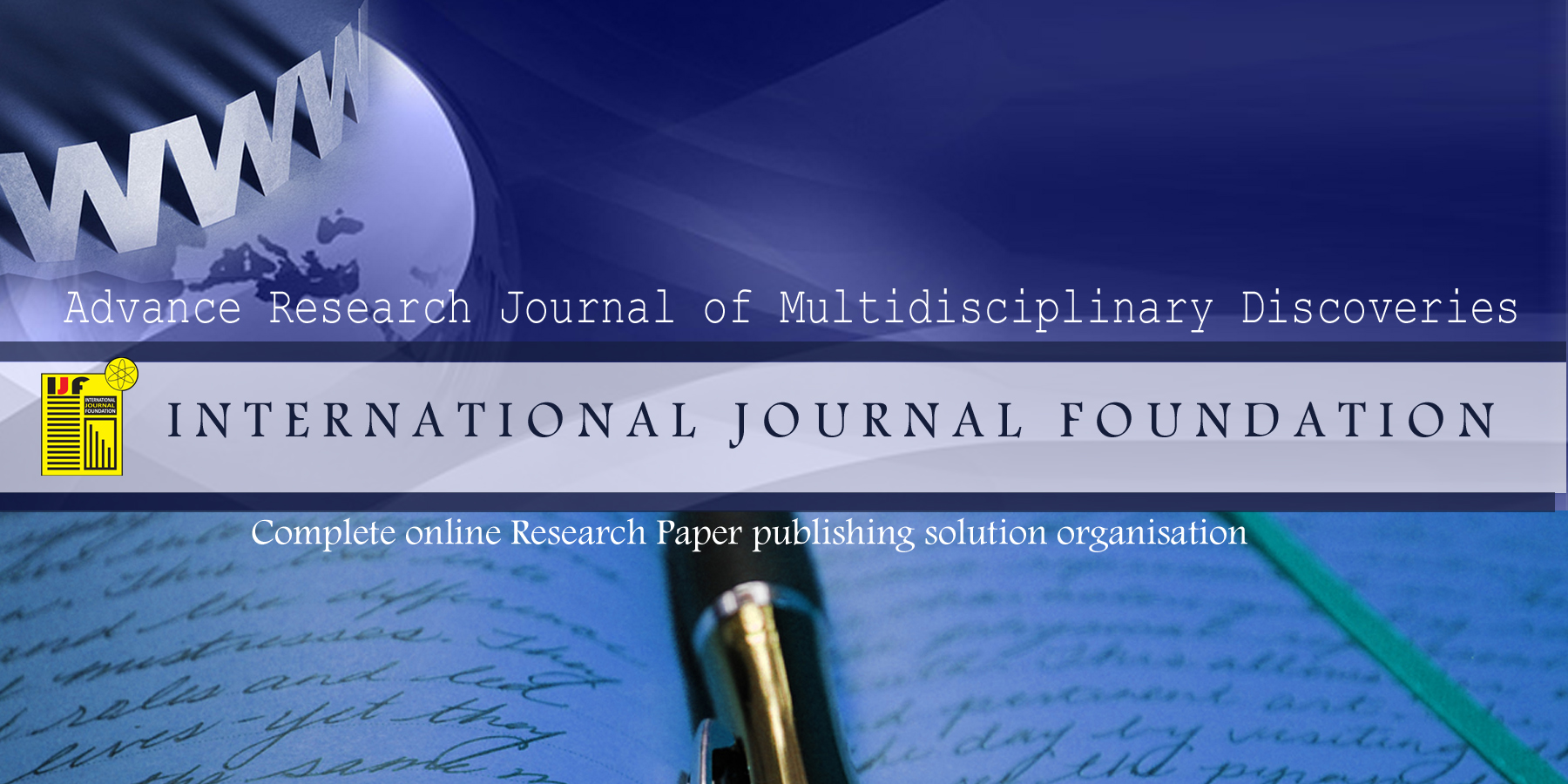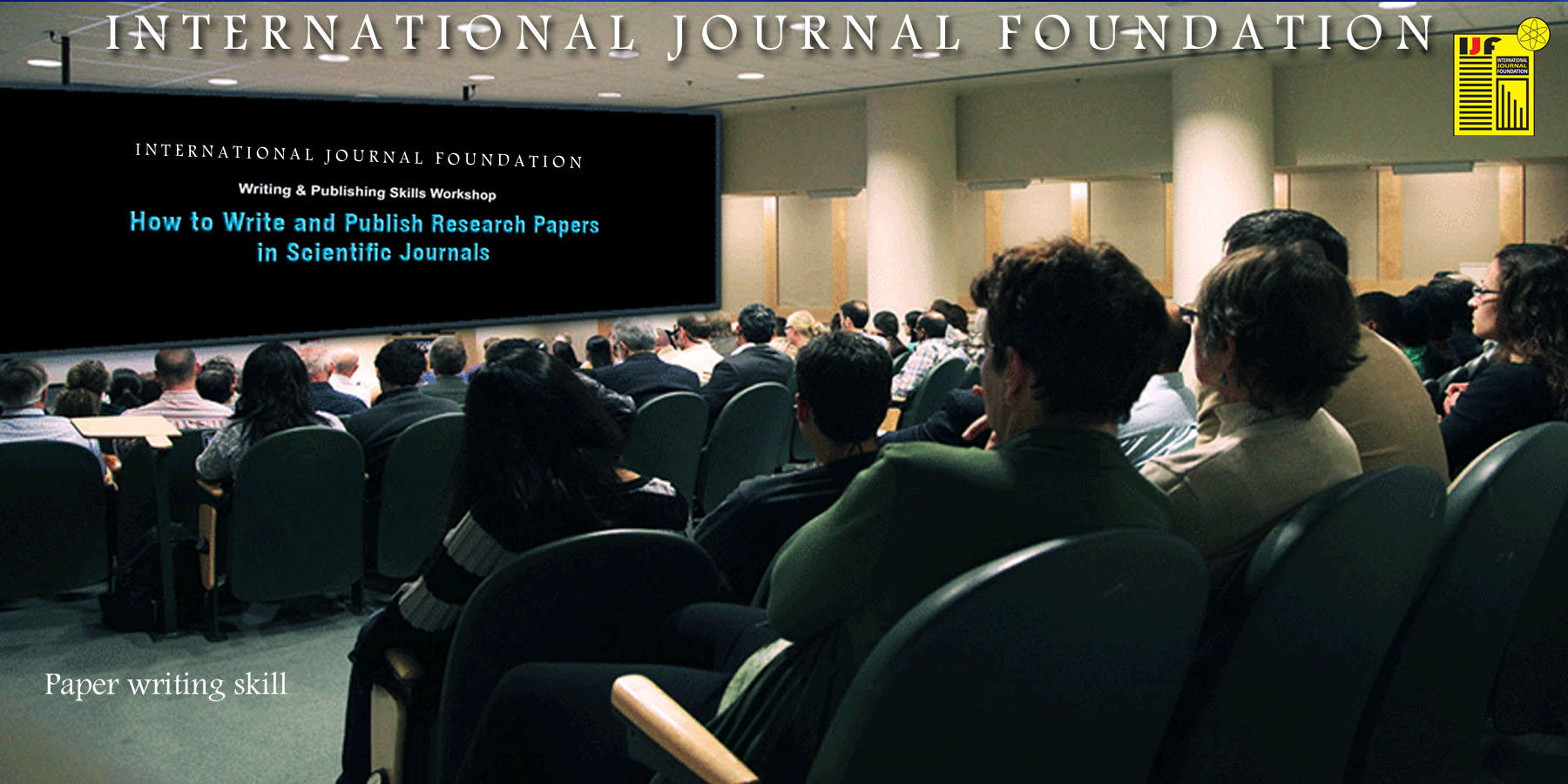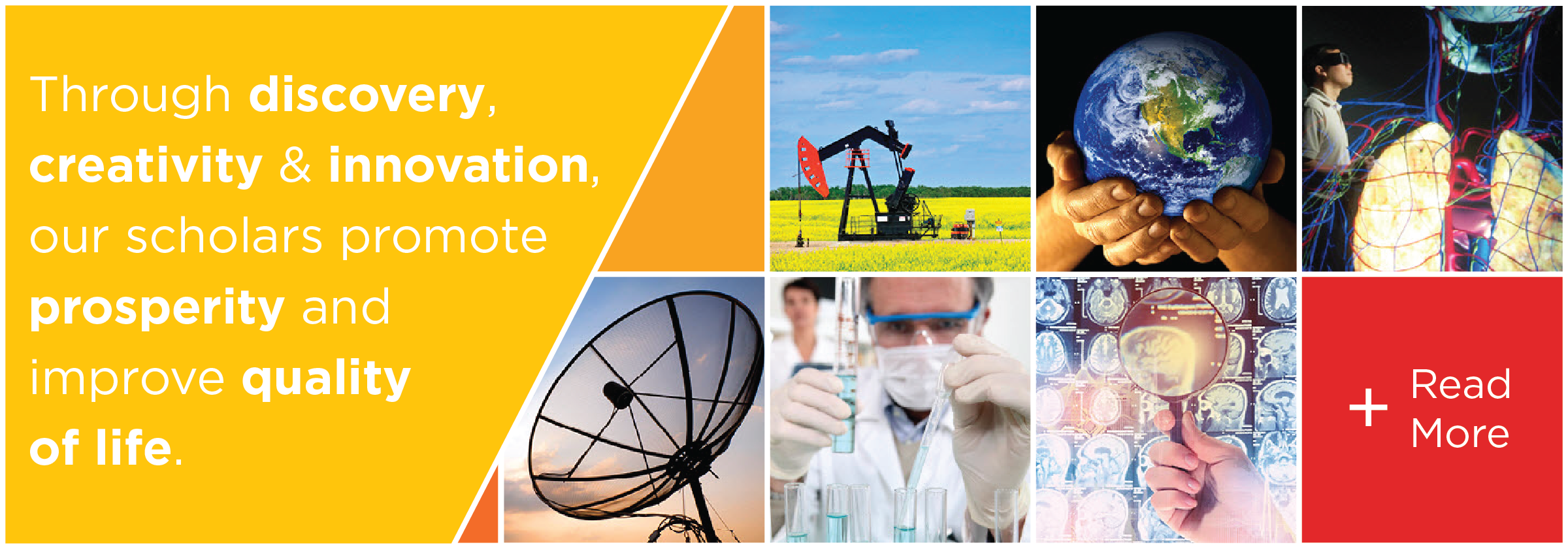2017
DECEMBER 2017/ Vol.20.0/ Issue-I
CATEGORY : Research Topic on Medical Science
| SL.No. | Detailed information of the published article |
| 1 | TITLE NAME: Testosterone Profiles and Haematological Parameters of Yankasa Rams following Cypermethrin Treatment. Author’s Name : Ubah Simon. Azubuike*1, Ogwu David2, Rekwot Peter Ibrahim3, Rwuaan Joseph Sankey 4, Agbonu Oluwa Adikpe5 Article Type : ORIGINAL RESEARCH ARTICLE Country from : NIGERIA Date of Publication: 05-01-2018 Journal Name : Advance Research Journal of Multidisciplinary Discoveries [ ISSN : 2456-1045 ] Article Identification : Vol. 20.0/Chapter-I/Page – 01-06 [ DECEMBER-2017 ISSUE ] Article Code : MDS-V20-I1-C1-DEC2017 Status : Officially published Publisher : International Journal Foundation Download: E-Certificate, Full Article (pdf) —————————————————————————————————————————– Abstract : This study was designed to investigate the testosterone profiles and haematology of Yankasa rams treated with Cypermethrin. Sixteen rams aged 18 – 30 months and weighing between 21.5 – 46.5kg were used. The rams were divided equally into two groups (A and B) A served as the treatment group while group B was the control. click here .The rams in (A) were given Cypermethrin (3%) at the dose rate of 3mg/kg (0.1ml/kg) b.w. (B) rams were given distilled water. These treatments were repeated forthrightly for a period of 12 weeks. 5ml of blood was aseptically collected weekly by jugular venipuncture using a 5 ml syringe and 18 gauge sterile needle from each of the animals between 8.00 and 10.00am. The collected blood samples were divided into two for haematology and testosterone assay. Packed cell volume, total white blood cell count and differential white blood cell count were done using the blood in anticoagulant bottle, while the serum samples were used for testosterone assay. Bovine testosterone (T) ELISA KITS (Wkea®) were used. Results showed no statistically significant difference between the two groups during the treatment period (P>0.05) across the parameters measured. It was concluded that topical application of Cypermethrin at the dose rate of 3mg/kg body weight for twelve weeks to Yankasa rams did not affect the serum testosterone profiles and haematological parameters measured. It was recommended that further studies be extended to the bovine species to establish more data about testosterone profiles and haematology in ruminants treated with Cypermethrin.Keywords : Testosterone, Haematology, Cypermethrin, Yankasa, rams.

|
CATEGORY : Research Topic on Business Management
| SL.No. | Detailed information of the published article |
| 2 | TITLE NAME : Challenges to manufacturing sector to make ‘ MAKE IN INDIA ‘ mission successful. Author’s Name : Mr. Sangram Padhy Article Type : ORIGINAL RESEARCH ARTICLE Country from : INDIA Date of Publication: 05-01-2018 Journal Name : Advance Research Journal of Multidisciplinary Discoveries [ ISSN : 2456-1045 ] Article Identification : Vol. 20.0/Chapter-II/Page – 07-10 [ DECEMBER-2017 ISSUE ] Article Code : BM-V20-I1-C2-DEC2017 Status : Officially published Publisher : International Journal Foundation Download: E-Certificate, Full Article (pdf) —————————————————————————————————————————– Abstract : Make in India is the best innovative idea to create a huge foreign investment for the country. The initiative taken to create the job opportunities and increase the Gross Domestic Product of the country and competition in the developing world. Make in India is proposed to make India a manufacturing hub of the world. click here The idea is to increase the involvement of the manufacturing sector to India’s GDP. The paper also focuses on the challenges of Make in India Campaign and the strategies which can be used to make the Make in India Campaign successful. We wish to analyze how this campaign can improve upon the present conditions of manufacturing sector as well as for India. Make in India is the key to revitalization of Indian economy. It is one of the schemes to pull back the economy from clutches of recession. Make in India initiative aims to correct the composition of Indian GDP which is the root cause of recession. Currently India’s GDP is heavily tilted in favour of service sector. Manufacturing sector of a country plays a major role in the growth of an economy. The development of this sector is an indicator of the economic strength of a country. It helps in raising productivity, generating employment and also supports other sectors of the economy. There are miles and ‘miles to go’ before celebrating the success of this campaign as there are huge obstacles that need to be overcome like simplifying the stringent laws and regulations, introducing the transparency in the process, building the best infrastructure, reforming labour laws, improving labour skill, etc.Keywords :Manufacturing Sector,Make in India,GDP,Job employment.

|
CATEGORY : Research Topic on Business Management
| SL.No. | Detailed information of the published article |
| 3 | TITLE NAME : Cashless India : Challenges & Opportunities Author’s Name : Mr. Mangulu Charan Das Article Type : ORIGINAL RESEARCH ARTICLE Country from : INDIA Date of Publication: 05-01-2018 Journal Name : Advance Research Journal of Multidisciplinary Discoveries [ ISSN : 2456-1045 ] Article Identification : Vol. 20.0/Chapter-III/Page – 11-15 [ DECEMBER-2017 ISSUE ] Article Code : BM-V20-I1-C3-DEC2017 Status : Officially published Publisher : International Journal Foundation Download: E-Certificate, Full Article (pdf) —————————————————————————————————————————– Abstract : As Indians queue up for cash in banks and ATMs, the question of whether India will successfully transition to a cashless economy stays strong in our minds. A cashless economy is one where cash flow is minimal or non-existent. In a cashless economy, electronic channels like a debit card, credit card, electronic merchants, payments such as IMPS are the mode of transaction. click here India has been a cash-dependent economy, with 97-98% of all transactions still in cash. Only half the nation’s adult population i.e. around 233 million, possess a bank account, a precursor to a cashless economy. Most retailers don’t accept cards or don’t have the infrastructure for online payments limiting the ability to use cards. Bank accounts or online banking are not of any use even when people have access to it if retailers want the payment in cash bank accounts or online banking are of no use. After the news of demonetization, the online payment services went into advertising overdrive, bombarding the media with ads to move onto online platforms. But wealthier urbanites or younger generation used most of the services. India being an agrarian economy we have to take them into consideration too. Banks are still doing poorly in rural areas. According to World Bank, there are only 18 ATMs per 100,000 citizens in India, compared to 129 in Brazil. Only 17 percent have smartphones and 22 percent use the Internet according to a Pew Research Center report.Keywords :economy,cashless,ATMs,an agrarian,urbanites,smartphones.  |
CATEGORY : Research Topic on Medical Science
| SL.No. | Detailed information of the published article |
| 4 | TITLE NAME : Impact of Mass treatment , Snail control and health education on the prevalence of Schistosoma haematobium among pupils in rural area at Kosti locality – White Nile State, Sudan (2011-2014) Author’s Name : Abdelrhman A.G. Altijani 1, Hassan Elbashir2, Abdelrahman Samira3, Nour Bakri4 Article Type : ORIGINAL RESEARCH ARTICLE Country from : SUDAN Date of Publication: 05-01-2018 Journal Name : Advance Research Journal of Multidisciplinary Discoveries [ ISSN : 2456-1045 ] Article Identification : Vol. 20.0/Chapter-IV/Page – 16-22 [ DECEMBER-2017 ISSUE ] Article Code : MDS-V20-I1-C4-DEC2017 Status : Officially published Publisher : International Journal Foundation Download: E-Certificate, Full Article (pdf) —————————————————————————————————————————– Abstract : An interventional study was conducted in rural areas Kosti Locality- White Nile State, Sudan during the period from (June 2011- March 2014). Study aims to determine the prevalence of Schistosoma haematobium among pupils, to identify the most affected age group and to assess the Impact of these interventions on prevalence of Schistosoma haematobium. click here A total of 400 pupils were interviewed using questionnaire to assess knowledge as a factor related to schistosomiasis. The prevalence of infection was significantly higher among boys than girls (P ≤ 0.05). No significantly different between age groups, and between the study areas, Umm-hani (1.95%) and El-tawella (1.1%) but in El-hamaraya it was significantly different (9.67%). The interventions (mass treatment, health education and snail control) reduced the prevalence of schistosomiasis in the study areas 15 months after interventions at Umm-hani and El-tawella. Mass treatment and snail control showed erratic results at Al-hamaraya. The study concluded that the interventions (mass treatment and health education) were effective to reduce the prevalence of S. haematobium than (mass treatment and snail control).Keywords :Schistosoma haematobium,Mass treatment,Health Education,White Nile State, Sudan. 
|
CATEGORY : Research Topic on Medical Science
| SL.No. | Detailed information of the published article |
| 5 | TITLE NAME : Emerging health issues among Narcotic Addicts – A Survey Study Author’s Name : Dr. Kulatunga R.D.H. Article Type : ORIGINAL RESEARCH ARTICLE Country from : SRI LANKA Date of Publication: 05-01-2018 Journal Name : Advance Research Journal of Multidisciplinary Discoveries [ ISSN : 2456-1045 ] Article Identification : Vol. 20.0/Chapter-V/Page – 23-26 [ DECEMBER-2017 ISSUE ] Article Code : MDS-V20-I1-C5-DEC2017 Status : Officially published Publisher : International Journal Foundation Download: E-Certificate, Best Paper Award Certificate, Full Article (pdf) —————————————————————————————————————————– Abstract : Narcotic addiction is a recent phenomenon in Asian countries. In Sri Lanka, Heroin, cannabis, opium and intoxicants like liquor are among the mostly used narcotics and have been increasing over the last decade. Currently, over two hundred fifty thousand people of Sri Lanka are addicted to drugs. click here By using those drugs, people are affected with various mental, physical, and social difficulties. The research work has undertaken the task to find out health issues that are prevailing among drug addicts. The study used primary data drawn from a purposive sample of hundred people who were drug addicts belonging to both genders. The research is adopted as a descriptive cross sectional study through an interviewer-administered questionnaire. The data revealed that youth and the middle aged people were most vulnerable to drug addiction. Physical disorders inflicting the drug addicts were high blood pressure, gastritis, bronchial asthma, skin diseases and majority were affected with neurological disorders.. Furthermore, mental disorders suffered by the drug addicts were anxiety, depression, impairment of memory power and Phobia etc. In addition, the main causative factors that drove people to take drugs were the influence caused by friends, easy availability of drugs, the urge to forget worries, for entertainment, and to increase creative instincts etc. With a view to minimize the menace of drug addiction, an awareness program targeting the youth and middle aged people informing the various social and physical disorders associated with drugs is being initiated through rehabilitation centers across the island .Keywords : Drug Addiction, Physical and Mental Disorders, Causes, Narcotics.

|
CATEGORY : Research Topic on Agricultural Science
| SL.No. | Detailed information of the published article |
| 6 | TITLE NAME : Effect of foliar application of Salicylic acid and Prohexadione-calcium on leaf nutrient content of apple cv. “Red Delicious”. Author’s Name : Kousar Javaid & Fayaz Ahmad Misgar Article Type : ORIGINAL RESEARCH ARTICLE Country from : INDIA Date of Publication: 07-01-2018 Journal Name : Advance Research Journal of Multidisciplinary Discoveries [ ISSN : 2456-1045 ] Article Identification : Vol. 20.0/Chapter-VI/Page – 27-29 [ DECEMBER-2017 ISSUE ] Article Code : AGS-V20-I1-C6-DEC2017 Status : Officially published Publisher : International Journal Foundation Download: E-Certificate, Full Article (pdf) —————————————————————————————————————————– Introduction : Present experiment entitled “Effect of foliar application of salicylic acid and prohexadione-calcium on leaf nutrient content of apple cv. Red Delicious” was conducted at private orchard Nikas, Pulwama during 2014 and 2015. click here The experiment comprising of 10 treatments viz., control, salicylic acid (SA) @ 50 ppm, 100 ppm, 150 ppm and 200 ppm, prohexadione-calcium @ 600 ppm, SA @ 50 ppm + prohexadione-calcium @ 600 ppm, SA @ 100 ppm + prohexadione-calcium @ 600 ppm, SA @ 150 ppm + prohexadione-calcium @ 600 ppm and SA @ 200 ppm + prohexadione-calcium @ 600 ppm was laid out in Randomized Complete Block Design with three replications. The results revealed that leaf nutrient content was significantly affected by treatments during both the years. Highest leaf N (2.58 and 2.70 %), P (0.33 and 0.38 %), K (2.07 and 2.13 %) and Ca (2.20 and 2.23 %) content was recorded in trees sprayed with SA @ 150 ppm + prohexadione-calcium @ 600 ppm and lowest leaf N (2.01 and 1.98 %), P (0.12 and 0.16 %), K (1.75 and 1.78 %) and Ca (1.57 and 1.62 %) content was recorded in trees receiving no treatment. Thus it may be concluded from the present investigation that combined spray of salicylic acid and prohexadione-calcium proved beneficial in improving the nutrient content of apple trees.
Keywords : Apple, foliar spray, leaf nutrient content, prohexadione-calcium, salicylic acid. 
|
CATEGORY : Research Topic on Agricultural Science
| SL.No. | Detailed information of the published article |
| 7 | TITLE NAME : Effect of foliar application of orthosilicic acid on leaf and fruit nutrient content of apple cv. “Red Delicious”. Author’s Name : Kousar Javaid & Fayaz Ahmad Misgar Article Type : ORIGINAL RESEARCH ARTICLE Country from : INDIA Date of Publication: 07-01-2018 Journal Name : Advance Research Journal of Multidisciplinary Discoveries [ ISSN : 2456-1045 ] Article Identification : Vol. 20.0/Chapter-VII/Page – 30-32 [ DECEMBER-2017 ISSUE ] Article Code : AGS-V20-I1-C7-DEC2017 Status : Officially published Publisher : International Journal Foundation Download: E-Certificate, Full Article (pdf) —————————————————————————————————————————– Abstract : Present investigation on the “Effect of foliar application of orthosilic acid on leaf and fruit nutrient content of apple cv. Red Delicious.” was undertaken at a private orchard Pulwama during 2014 and 2015. The experiment comprising of five treatments viz, control, orthosilicic acid @ 0.5 ml/litre, 0.75 ml/litre, 1.5 ml/litre and 3.0 ml/litre was laid out in Randomized Complete Block Design with three replications. click here The trees were treated with foliar sprays of orthosilicic acid at green tip stage, petal fall stage, fruitlet stage, fruit development stage-II and fruit development stage-III. The results revealed that leaf and fruit nutrient content was significantly affected by treatments. Maximum leaf N (2.18 and 2.15 %), P (0.30 and 0.27 %), K(2.21 and 2.18 %) and Ca (1.95 and 1.90 %) content and fruit N (0.53 and 0.57 %), P (0.052 and 0.057 %), K (0.65 and 0.69 %) and Ca (0.060 and 0.064 %) content was recorded in trees sprayed with orthosilicic acid @ 3.0 ml/litre during the two years respectively which was at par with leaf N (2.07 and 2.04 %), P (0.28 and 0.24 %), K (2.09 and 2.03 %) and Ca (1.85 and 1.81 %) content and fruit N (0.51 and 0.55 %), P (0.050 and 0.053 %). K (0.63 and 0.66 %) and Ca (0.058 and 0.062 %) content in trees sprayed with orthosilicic acid @ 1.5 ml/litre. In conclusion the result of this study highlights the role of silicon in improving nutrient content in apple.Keywords : Apple, foliar spray, orthosilicic acid, leaf nutrient content.

|
CATEGORY : Research Topic on Agricultural Science
| SL.No. | Detailed information of the published article |
| 8 | TITLE NAME : Effect of fruit extracts on it vitro growth of Salvadora Persica. Author’s Name : Beena Naqvi1*, Haider Abbas2*, Sheikh Umair Ali3, Muhammad Buksh4, Fazal-Ur-Rahman5, Zoraiz Jamil6, Nabeel Farooqi7, Basit Khan8, Abdul Basit9, Tahir Qureshi10, Saad Ali11 and Syed Fayaz-Uddin12 Article Type : ORIGINAL RESEARCH ARTICLE Country from : PAKISTAN Date of Publication: 07-01-2018 Journal Name : Advance Research Journal of Multidisciplinary Discoveries [ ISSN : 2456-1045 ] Article Identification : Vol. 20.0/Chapter-VIII/Page -33-37 [ DECEMBER-2017 ISSUE ] Article Code : AGS-V20-I1-C8-DEC2017 Status : Officially published Publisher : International Journal Foundation Download: E-Certificate, Full Article (pdf) —————————————————————————————————————————– Abstract: Effect of different fruits and vegetables juices in MS medium was investigated on growth of Salvadora persica under in vitro culture. Healthy tissues taken from mature plant and grow on a MS0 medium for six weeks under 16hr light and 8hr dark condition, after 6 weeks subculture on MS medium [supplement with different juices, MS1 (Carrot), MS2 (Coconut water), MS3 (Orange), MS4 (Strawberry), MS5 (Tomato)] and MS0 use as a control. click here The growth parameters studied included number of leaves (fresh and pale), number of branches and height of shoots. Result shows that out of 5 medium only MS2 (Coconut water) shows effective result in all parameters. It is concluded that other natural juices in addition with the natural compounds of S. persica have growth inhibition effect instead of enhancing growth.Keywords : fruit juices, Murashige and Skoog (MS), Salvadora persica

|
CATEGORY : Research Topic on Applied Science
| SL.No. | Detailed information of the published article |
| 9 | TITLE NAME : “Role of Vertical Electrical Sounding (VES) for Geologycal, Hydro-Geophysical investigation for sitting water well : A case study of UKE, East Wollega Zone, Western part of Ethiopia” Author’s Name : Dr. Shayaq Ali and Dr. Gaddissa Deyassa Article Type : ORIGINAL RESEARCH ARTICLE Country from : ETHIOPIA Date of Publication: 07-01-2018 Journal Name : Advance Research Journal of Multidisciplinary Discoveries [ ISSN : 2456-1045 ] Article Identification : Vol. 20.0/Chapter-IX/Page – 38-43 [ DECEMBER-2017 ISSUE ] Article Code : AS-V20-I1-C9-DEC2017 Status : Officially published Publisher : International Journal Foundation Download: E-Certificate, Full Article (pdf) —————————————————————————————————————————– Abstract: Groundwater is precious resource for life growth and development of country. Hence, reliance on the groundwater has increased greatly. This research was conducted in the Uke town, East Wollega zone, western part of Ethiopia. The study catchment is a watershed area drained by a small stream that joins Anger river from southern direction. The topographic variation in the study catchment ranges from 1287 to about 1337m. click here The occurrence of Paleozoic sedimentary rocks in the study area and this includes fine grained sandstone which is variably exposed in stream cut and at the bank of Anger river. Bedding structures that reaches as thick as 25cm are observed on the sandstone, however, thinly bedded with evident lamellae are abundantly exposed at the bank of Anger river. The regional stratigraphic sequence suggests that the Paleozoic sandstone overlays the eroded surface of Precambrian basement rocks. The major hydro geologic unit in the study area is the sandstone rock which covers the major portion of the study area. The sandstone is subjected to fracturing, jointing and local faulting processes.This paper presents the results of geological, hydro-geophysical investigation carried out over the study area and the objective of this study for sitting water well in water bearing horizon, correct location, depth of aquifer well, and good discharge rate. This is possible by a systematic exploration of groundwater using by different scientific tools and also using geological, hydro geological and geophysical methods provides valuable information with respect to distribution, thickness, and depth of groundwater bearing formation zones. In this research, using in geophysical methods, only Vertical Electrical sounding (VES), because it is low cost and relatively high reliable accuracy in results. Vertical Electrical Soundings (VES) survey was carried out by using the symmetrical Schlumberger expanding spread. In this method, the resistivity measurements were taken by progressively increasing the Potential Electrode (MN) along with a relatively large increment of the Current Electrode (AB/2). The Potential Electrode (MN) separation ranges from 1m to 90m whereas; the Current Electrode Separation (AB/2) of 500m was stretched to achieve maximum depth of penetration. Signal Average System Terra meter300C was used for the resistivity measurement of resistivity survey. Like the model for VES1 the model for VES2 also represented 5 geo electric layers. The first layer has resistivity value of about 27Ωm. and this represents dry silty alluvial soil with thickness nearly 2meter. The second layer with significantly reduced resistivity value of about 16Ωm can possibly be interpreted to be sandy to silty soil of thickness nearly 10m. This succession gradually grades to fractured sandstone bedrock as it is manifested by relative increment of resistivity value to about 640Ωm. The study area, the major identified potential aquifers are the fractured bedrock, it comprises fractured, jointed and bedded sandstone. Groundwater Potential sites (proposed well sites) are selected based on converging evidences of litho logy and structures.Keywords : Aquifer, Groundwater exploration, Paleozoic sandstone, Resistivity, Vertical electrical sounding.

|
CATEGORY : Research Topic on Entomology
| SL.No. | Detailed information of the published article |
| 10 | TITLE NAME :“Successful Reproductive Cycle Strategy (Extra-pair copulations in Nicrophorus Germanicus (LINNAEUS,1758)) ( Nicrophorus Kirby; Silphidae Coleoptera” Author’s Name : Sergey Viktorovich Pushkin Article Type : ORIGINAL RESEARCH ARTICLE Country from : RUSSIA Date of Publication: 20-01-2018 Journal Name : Advance Research Journal of Multidisciplinary Discoveries [ ISSN : 2456-1045 ] Article Identification : Vol. 20.0/Chapter-X/Page – 44-46 [ DECEMBER-2017 ISSUE ] Article Code : ENTO-V20-I1-C10-DEC2017 Status : Officially published Publisher : International Journal Foundation Download: E-Certificate, Full Article (pdf) —————————————————————————————————————————– Abstract: The parent instincts male burying beetles, Nicrophorus spp. are put under doubt when, conspecific females invade on a substratum prepared for oviposition. Though females provide males with padding possibilities of pairing, they put under threat a survival of the male’s brood of “parent”. click here To research sexual answer of the parent’s males to females, which invade in their nests, we added the virginal beetles (female) to nest conspecific a steam, which already have initiated to care of descendants. Half of the females (invader) were inseminated by males the parents in trials, with Nicrophorus germanicus (Linnaeus, 1758). In work the author reduces the experimental data obtained during laboratory learning of genesial cycle and the sexual ratioes for the beetles of a genus Nicrophorus Kirby Nicrophorus germanicus. Extra-pair copulations for Coleoptera are poorly investigated. In work this act for N. germanicus for the first time is featured. In work we shall try to give an explanation to the obtained outcomes. Keywords : Extra-Pair Copulations, Nicrophorus germanicus (Linnaeus, 1758), Parental Care, Brood-Care Behavior, Burying Beetles.

|
CATEGORY : Research Topic on Agricultural science
| SL.No. | Detailed information of the published article |
| 11 | TITLE NAME : “Rice (Oryza Sativa) cultivation in temperature areas of India” Author’s Name : Tanweer-Ul-Hassan Malik, Abrar Baba, S.A Haji, Shams- Ud-Din Mir and Showket A Dar Article Type : ORIGINAL RESEARCH ARTICLE Country from : INDIA Date of Publication: 20-01-2018 Journal Name : Advance Research Journal of Multidisciplinary Discoveries [ ISSN : 2456-1045 ] Article Identification : Vol. 20.0/Chapter-XI/Page – 47-57 [ DECEMBER-2017 ISSUE ] Article Code : AGS-V20-I1-C11-DEC2017 Status : Officially published Publisher : International Journal Foundation Download: E-Certificate, Full Article (pdf) —————————————————————————————————————————– ORIGIN OF RICE: Rice botanically called as Oryza Sativa, is associated with wet, humid climate, though it is not a tropical plant. It is probably a descendent of wild grass that was most likely cultivated in the foothills of the far Eastern Himalayas. Another school of thought believes that the rice plant may have originated in southern India, click here then spread to the north of the country and then onwards to China. It then arrived in Korea, the Philippines about 2000 BC, and then Japan and Indonesia 1000 BC(Anonymous, 2012).Further, genetic evidence has shown that rice originates from a single domestication 8,200–13,500 years ago (Molina et al., 2011) in the Pearl River valley region of China(Huanget al., 2012).India is also believed to be the origin of the rice (Pallavi 2011).In 327 B. C., it is believed thatfrom Greece, the Arab travelers took rice to Egypt, Morocco and Spain and that is how it travelled all across Europe.The journey of rice around the world has been slow, but once it took root it stayed and became a major agriculture and economic product for the people. In the Indian subcontinent more than a quarter of the cultivated land is given to rice (20011-14). It is a very essential part of the daily meal in the southern and eastern parts of India. In the northern and central parts of the subcontinent, where wheat is frequently eaten, rice holds its own position and is cooked daily as well as on festivals and special occasions.

|
N.B: Our publication process is going on. More paper will be added very shortly in this current issue…
(i) To Publish your paper in our upcoming issue send your article directly at article.ijf@gmail.com
( ii ) E- certificate from publisher are free of cost. To get a Original Hard copy of “Publication Certificate“ from please contact at journal.ijf@gmail.com
![]()
![]()
![]()
![]()
![]()
![]()
















